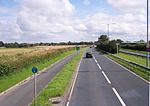Woodvale, Merseyside
Merseyside geography stubsSouthportTowns and villages in the Metropolitan Borough of SeftonUse British English from March 2021
Woodvale is the southernmost suburb of the town of Southport, Merseyside, England. It is situated between Formby and Ainsdale, to the north of RAF Woodvale.
Excerpt from the Wikipedia article Woodvale, Merseyside (License: CC BY-SA 3.0, Authors).Woodvale, Merseyside
Woodvale Road,
Geographical coordinates (GPS) Address Nearby Places Show on map
Geographical coordinates (GPS)
| Latitude | Longitude |
|---|---|
| N 53.5881 ° | E -3.0371 ° |
Address
Woodvale Road
Woodvale Road
PR8 3SU , Ainsdale
England, United Kingdom
Open on Google Maps






